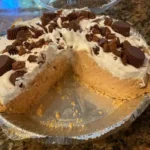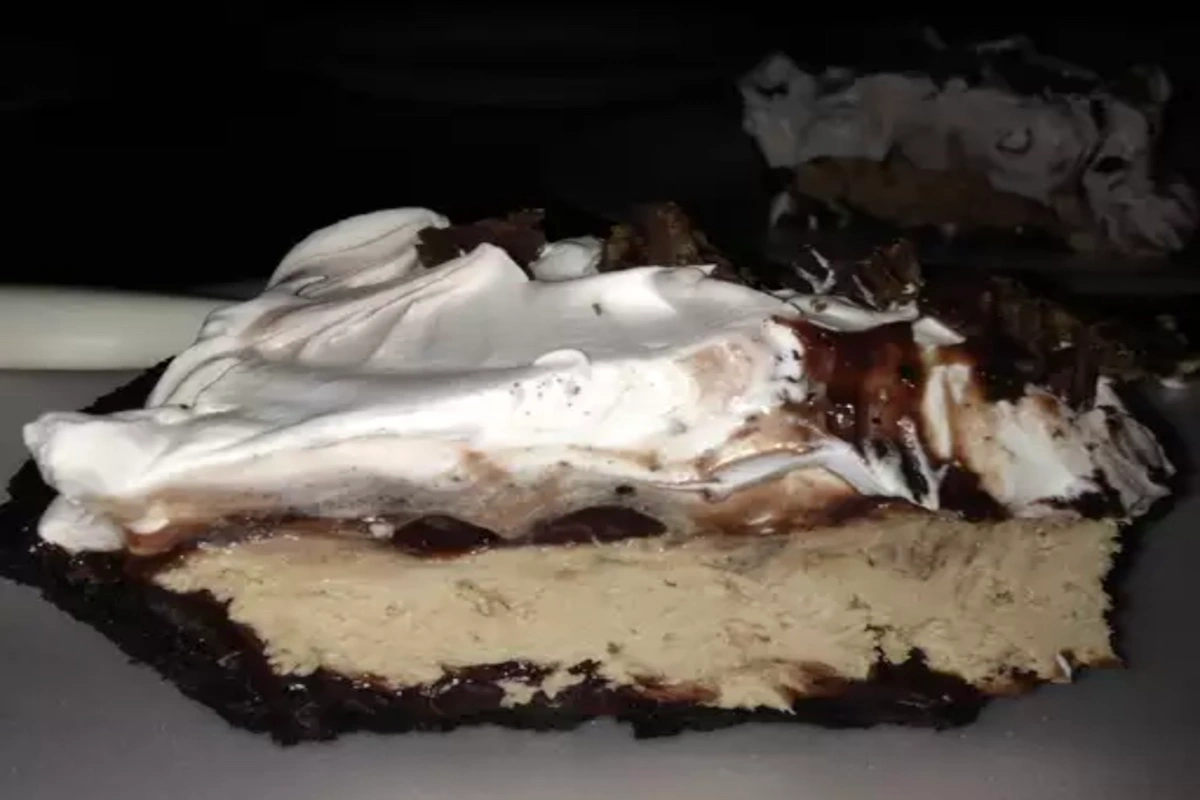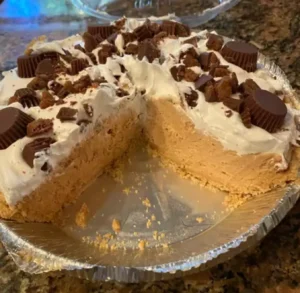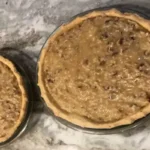Peanut butter pie is a beloved dessert that combines the rich, creamy texture of peanut butter with a delicious crust and often a sweet topping. While it’s a favorite for many, making the perfect peanut butter pie can be tricky.
There are several common mistakes that both novice and experienced bakers can make. I’ve seen many people criticize Peanut Butter Pie recipes for some critical ingredients which can really make the pie a failure.
I have a top 3 mistakes that I would try to avoid by all means. And there are a few other mistakes that I’ll state which you may be useful for those who are about to make this recipe. Oh, of course you can find the recipe I recommend to make a Peanut butter Pie below.
Adding Milk
Adding milk directly to a peanut butter pie filling is generally not recommended due to several reasons related to the texture and stability of the pie.
Many people criticize the inclusion of milk in peanut butter pie recipes. Some would steer away from adding milk or considering the recipe all at once. But for those who may be making it for the first time, these are some reasons to avoid adding milk:
Texture Issues
Peanut butter pie filling typically relies on ingredients like cream cheese, whipped cream, or condensed milk to create a thick, creamy texture. Adding milk can overly thin this mixture, leading to a filling that is too runny and doesn’t set properly in the pie crust.
Setting Problems
Many peanut butter pie recipes are designed to set firmly in the refrigerator, forming a sliceable, cheesecake-like texture. Milk, being more liquid, can interfere with this setting process, resulting in a pie that doesn’t hold its shape when cut.
Dilution of Flavor
Milk can dilute the rich, intense flavor of the peanut butter, leading to a less flavorful pie. The creamy and robust taste of peanut butter is a key component of the pie, and you wouldn’t want to weaken it.
Risk of Curdling
Depending on the acidity of other ingredients in the pie (like cream cheese or sour cream), adding milk could potentially lead to curdling. This would affect both the texture and appearance of the pie.
Balance of Ingredients
Baking and dessert recipes are often carefully balanced in terms of the ratio of dry to wet ingredients. Adding an extra liquid like milk can disrupt this balance, leading to various issues in the final product.
If you find that your peanut butter pie filling is too thick and you’re tempted to thin it with milk, consider these alternatives:
- Use Cream Instead: If you need to thin the mixture slightly, using a small amount of heavy cream can be a better option. It’s richer in fat and less likely to make the filling too runny.
- Adjust Other Liquids: Look at adjusting the quantities of other liquid ingredients in the recipe, if any, rather than adding an additional one.
- Soften the Peanut Butter: If the peanut butter is too stiff, gently warming it before mixing can make it easier to incorporate without needing extra liquid.
Always remember, when modifying a recipe, make small adjustments and check the consistency and flavor before making further changes.
Overlooking the Sweetness Balance: Achieving the Perfect Harmony
When crafting a peanut butter pie, one of the most critical aspects to consider is the balance of sweetness. Peanut butter, inherently rich and savory, forms the heart of this dessert. However, its natural flavor profile can be easily overwhelmed if not carefully balanced with the right amount of sweetness.
Understanding Peanut Butter’s Natural Flavor
Peanut butter’s flavor is complex. It’s not just about the nuttiness; there’s an inherent depth that includes savory, slightly salty, and even bitter notes, especially in natural or unsweetened varieties. This complexity is what makes peanut butter so appealing, but it also means that adding sugar should be done thoughtfully.
The Role of Added Sugars
In many recipes, sugar is added to the peanut butter filling to enhance its sweetness. The key here is moderation. Excessive sugar can not only overpower the natural flavors of the peanut butter but also make the pie cloyingly sweet. It’s important to start with a smaller amount of sugar, taste, and then adjust accordingly. Remember, the goal is to complement the peanut butter, not to mask it.
Types of Sweeteners
The type of sweetener you choose can also impact the overall flavor profile. While granulated sugar is common, brown sugar can add a molasses-like depth, and honey or maple syrup can introduce subtle complex flavors. Each sweetener interacts differently with peanut butter, so consider experimenting to find your preferred taste.
Balancing with Other Ingredients
Other ingredients in your pie can also affect the sweetness balance. For instance, if your crust is particularly sweet, you might want to reduce the sugar in the filling. Similarly, if you’re adding a sweet topping like chocolate or caramel, this will also contribute to the overall sweetness of the dessert.
The Importance of Tasting and Adjusting
Tasting and adjusting as you go is crucial. Your palate is the best tool for ensuring the balance is just right. As you mix your filling, take a small taste. It should be pleasantly sweet but still allow the peanut butter’s natural flavors to shine through. If it’s too sweet, you can add a bit more peanut butter or a pinch of salt to counteract the sweetness.
Choosing the Wrong Peanut Butter
The type of peanut butter you use is crucial. Avoid using low-quality peanut butters that are overly processed and contain added sugars and oils. These can affect the texture and flavor of your pie. Opt for natural, creamy peanut butter for the best results.
The quality of peanut butter is paramount. Avoid using chunky or low-fat varieties, as they can alter the texture and flavor balance of your pie. A smooth, high-quality peanut butter will give you a creamy and rich filling.
In my case, my favorite by far, is the natural one I make at home. One variation is beyond Natural as it is only peanut butter. Yet, I play with the recipe depending on the mood and who’s going to eat it with me.
I made a short article about the natural peanut butter recipe I make.
Other Common Mistakes to avoid
1. Overworking the Crust
A good crust is the foundation of any pie. When making a peanut butter pie, it’s essential not to overwork the dough. Overworking can lead to a tough, chewy crust rather than a flaky, buttery one. Handle the dough as little as possible and keep your ingredients cold.
2. Not Pre-Baking the Crust
Pre-baking or ‘blind baking’ the crust is a step you shouldn’t skip. This process helps to prevent a soggy bottom and ensures that your crust is perfectly cooked. Without pre-baking, the moisture from the filling can make the crust soggy.
3. Skimping on Chilling Time
Rushing the chilling process is a common mistake. Peanut butter pie needs adequate time to set in the refrigerator, usually several hours or overnight. This step is crucial for achieving the right consistency and making the pie easier to slice.
4. Forgetting the Toppings
Toppings can transform your peanut butter pie from good to great. Whipped cream, chocolate shavings, or a drizzle of caramel can add an extra layer of flavor and texture. However, be mindful not to overpower the primary flavor of the peanut butter.
Conclusion
Avoiding these common mistakes will help you create a peanut butter pie that’s both delicious and satisfying. Remember, baking is as much about the process as it is about the ingredients. Take your time, pay attention to details, and most importantly, enjoy the journey of creating something delightful. Your perfect peanut butter pie awaits!
For the best flavor and texture, use a creamy, natural peanut butter. Avoid peanut butters with added sugars and oils, as they can affect the pie’s overall taste and consistency.
Pre-baking, or blind baking, the crust helps to prevent it from becoming soggy once the filling is added. It ensures that the crust is fully cooked and has a crisp texture, providing a perfect base for the creamy filling.
Yes, a store-bought crust can be a convenient option and works well for peanut butter pie. Just be sure to follow the instructions for pre-baking if required.
It’s best to chill your peanut butter pie for at least 4 hours, or overnight if possible. This allows the pie to set properly and makes it easier to slice.
Popular toppings include whipped cream, chocolate shavings, a drizzle of caramel or chocolate sauce, and chopped nuts. These add texture and complementary flavors to the pie.
Yes, peanut butter pie freezes well. Wrap it tightly in plastic wrap or aluminum foil, or place it in an airtight container. It can be stored in the freezer for up to 2 months. Thaw in the refrigerator before serving.

Peanut Butter Pie
- Total Time: ADD 4h + 20m
- Yield: 8 Servings 1x
Description
This Peanut Butter Pie combines a crunchy graham cracker crust with a creamy and rich peanut butter filling, topped with a light whipped cream and chocolate garnish. Perfect for any occasion, it’s a delightful dessert that’s both decadent and comforting.
Ingredients
For the Crust:
- 1 1/2 cups graham cracker crumbs
- 1/4 cup granulated sugar
- 1/2 cup melted unsalted butter
For the Filling:
- 1 cup creamy peanut butter
- 1 cup powdered sugar
- 1 cup heavy cream
- 8 oz cream cheese, softened
- 1 teaspoon vanilla extract
For the Topping:
- 1 cup heavy cream
- 2 tablespoons powdered sugar
- Chocolate shavings or mini chocolate chips for garnish
Instructions
- In a mixing bowl, combine the graham cracker crumbs, granulated sugar, and melted butter. Press the mixture firmly into the bottom of a 9-inch pie dish. Chill for at least 20 minutes.
- In another mixing bowl, beat together the creamy peanut butter, powdered sugar, heavy cream, softened cream cheese, and vanilla extract until smooth and well combined.
- Pour the peanut butter filling over the chilled crust and smooth the top with a spatula.
- Whip the heavy cream with the powdered sugar until stiff peaks form. Spread this over the peanut butter layer.
- Garnish with chocolate shavings or mini chocolate chips.
- Chill the pie for at least 4 hours or overnight before serving.
- Prep Time: 20
- Category: Dessert
- Cuisine: American
Nutrition
- Serving Size: 1
- Calories: 600-700
- Sugar: 30-40g
- Sodium: 200-300 mg
- Fat: 40-50
- Saturated Fat: 20-25
- Carbohydrates: 40 – 50g
- Fiber: 1g
- Protein: 10-15
- Cholesterol: 80-100 mg
Keywords: peanut butter pie, no-bake dessert, creamy pie, chocolate peanut butter



